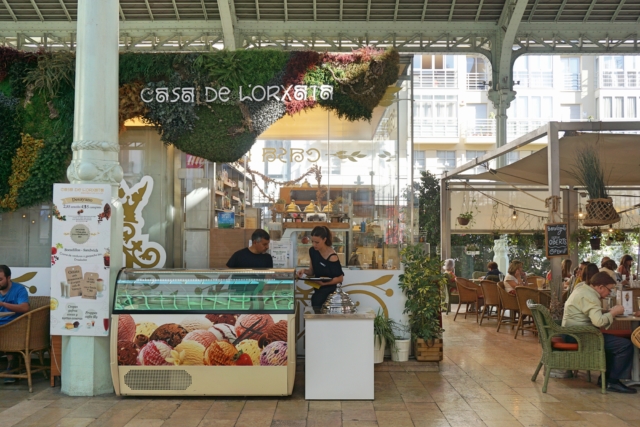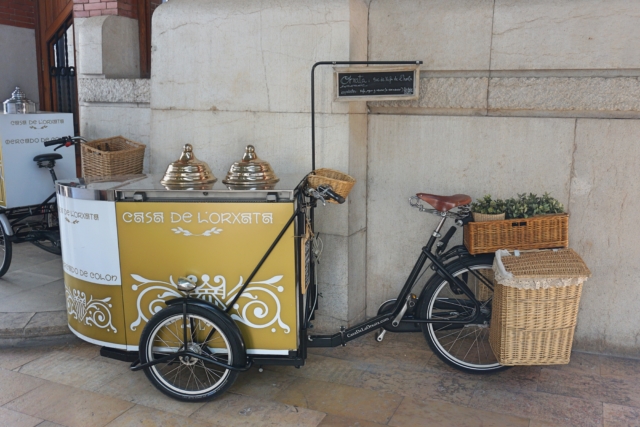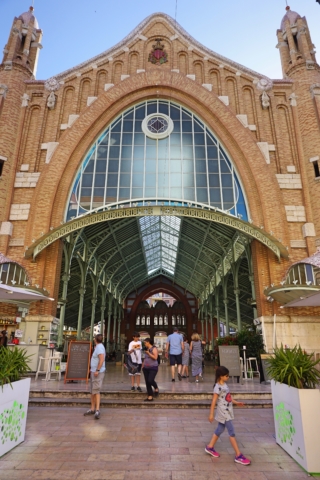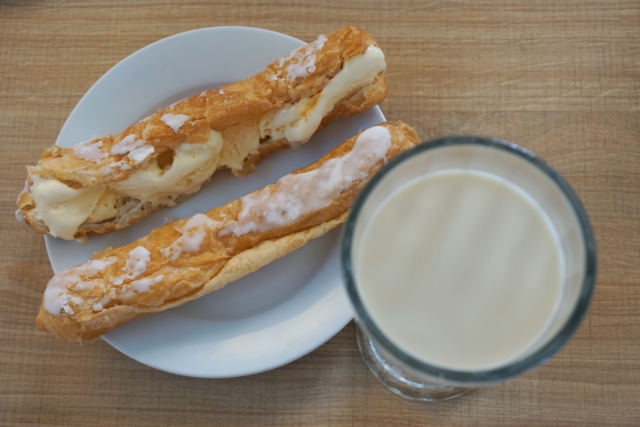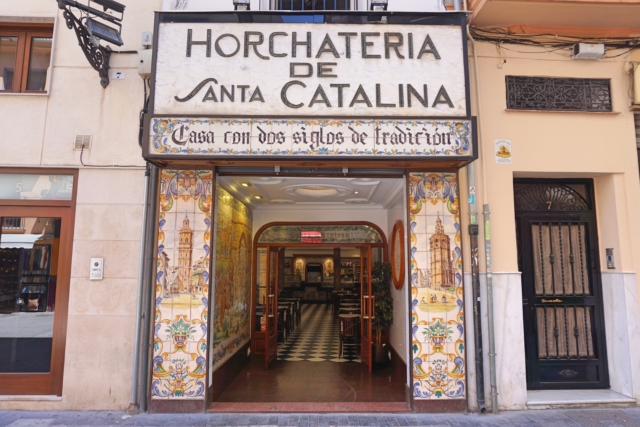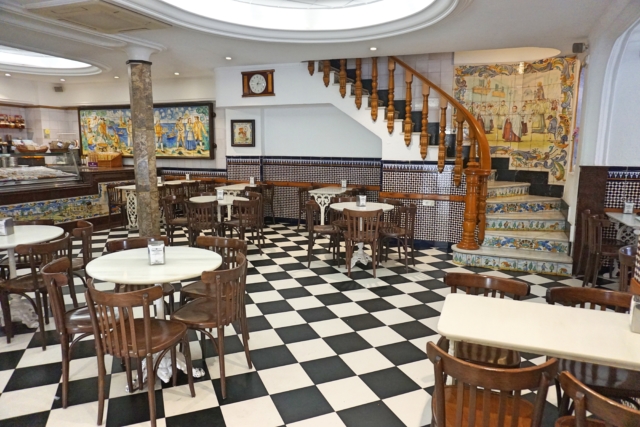The first time I came across horchata was on a hot summer day once upon a time in Valencia, sweat streaming down my face, as I was desperately searching for something cool, something refreshing. I found it in the street, not in the form of ice cream, but in the cold, sweet, lip-smackingly delicious horchata ladled out from big metal cylinders built into mobile roadside street carts and poured into paper cones. And if you see orxata written on them, don’t be confused, it’s the same thing, written in Catalan.
If you’re from the North American parts of this world, it’s likely that you will have heard of horchata, the Mexican drink, or of one of a number of other Middle- or South-American horchata varieties. I had come across horchata in Valencia first and was slightly puzzled about the drink and its origin once I heard about the South American concoction. The fact that there was a puzzle to solve made the research into this beverage even more exciting. And whether you’ve heard only of one or the other, or perhaps neither of them, you’re bound to discover some interesting facts – if nothing else.
In more Southern European countries such as France, Italy and Spain, before the introduction of a certain key ingredient of the popular Valencian horchata as we know it today, the drink was in essence a barley beverage. The word horchata in fact comes from the Italian orzata, which came from the Latin hordeata, which referred to a drink made with barley. Throughout its history, however, this “coloured water” (agua colorosa) has taken on many other forms as well, whereby the drink was made with a diverse range of ingredients such as cereals, almonds, or dried fruits.
After a significant reshuffling of religions and cultures, bringing with it new foods and influences, barley or any other ingredient used in the horchata drink were replaced by chufa, or tiger nut in English – a perhaps confusing translation since it’s not actually a nut but a small tuber whose roots are similar in form to a hazelnut. It had already been used for consumption in ancient Egypt since roughly 4,000 years ago, then spread to North Africa and reached Sicily and the Iberian Peninsula with the Islamic waves of the Middle Ages. Since Islam prohibits alcoholic beverages, it is only natural that other types of drink such as horchata de chufa were developed when new foods such as tiger nuts brought over by new settlers were cultivated locally.
Thus chufas were introduced to the Valencian community in the eighth century during the Muslim occupation which lasted from 711 to 1492, although it was not until the thirteenth century that the first references were made to la leche de chufas (“chufa milk”), a predecessor to the contemporary horchata. Since chufas can only be grown in specific types of soil, and given the history of the ingredient in Valencia, horchata received the Designation of Origin status in 1995 by the Valencia Regional Government. A regulating council ensures the quality of the product in every phase from plantation, to washing, to drying and selecting. Today, chufa is cultivated in no less than sixteen municipalities of the province of Valencia, with Alboraya being the best-known.
Although the Valencian horchata looks and even tastes like a milky drink, it actually contains no lactose, since it is made only out of water, chufa, and a customizable amount of sugar – these days the trend is towards less sugar and more pure chufa content, as the Casa de l’Orxata Horchatería in Valencia advertises. And not only is the drink lactose-free, but it’s also vegetarian- and vegan-friendly, and contains zero gluten. In terms of its nutrient-content it can compete very well with other drinks of vegetable origin.
In written accounts, Persian and Arabic authors of antiquity already mentioned the chufa tuber’s digestive and disinfectant health benefits, and their consequent use in medicinal drinks. Aside from this, tiger nuts are also believed to be energizing, thus making the horchata an invigorating yet caffeine-free drink. For a full list of further health benefits you can visit the Casa de l’Orxata website here. They pride themselves in offering a natural and organic version of horchata, rather than a pasteurized and industrialized one, making it a much more wholesome drink.
When tiger nuts are harvested, they are gathered in special drying rooms for at least three months. Through this slow drying process a good amount of the sweetness in the horchata drink comes from the tuber itself, because carbohydrates in the chufa are given enough time to gradually turn into sugars. Fresh horchata is then made from the tiger nuts soaked in water with added sugar. This mixture is blended and passed through a sieve, leaving just the thick white liquid that is served ice-cold to expectant customers like me.
Horchata is sold commercially in supermarkets and is thus widely available throughout Spain. However, the horchaterías and horchata roadside stands are specific to Valencia where this drink originates. On a hot summer day, you’ll find yourself blessed to come across an horchata street stall with an horchatero ladling out the ice-cold drink and filling it into a cone-shaped cup for you to relish. In horchaterías they can usually be ordered líquida (liquid) or granizada (slightly frozen) – the perfect alternative to ice cream.
What of the horchatas to be found in Latin America? Here the drink has evolved into something different. Instead of including the chufa tuber that is particular to the Valencian horchata, other ingredients such as rice flour, cinnamon, vanilla, almonds, and coconut are used. Due to the ground rice that makes up one central component in many horchata varieties found in South America, the drink will be a lighter, more floral-tasting version. In countries such as Venezuela there is even an alcoholic variant called chicha andina, and in Ecaduor the drink is a clear, red infusion of no less than eighteen herbs. There exist enough varieties to go on a South American horchata tour.
But if you find yourself in Valencia, ready to try the unique horchata de chufa drink, then the following two horchaterías will not disappoint. Casa de l’Orxata in the historic Mercado de Colón make their smooth horchata with organic ingredients and also sell it from street carts around town. They offer gluten-free and lactose-free ice cream, as well as vegan smoothies and other vegetarian treats.
A family business which started out over ten years ago, it not only advocates for natural, organic ingredients, but promotes local, sustainable products as well. Their bici-carritos, a little horchata stall on wheels (the bicycle-kind), is just one of the examples showcasing their commitment to organic and sustainable food and drinks.
It will come as no surprise then to find that the horchata they offer is vegetarian, natural, raw, gluten-free, lactose-free, non-pasteurized and without preservatives. It even comes with a leaflet of instructions on how to convert your palate to one of an expert horchatero. Much like in bubble tea places, you can choose between a normal-level, low-level, and zero-level sugar version. For an “excellent” horchata, they recommend the non-sugar one, although adding some sugar to it is still considered the more traditional or “normal” way, as they refer to it. Since I wanted to taste the horchata of my memories, I went for the normal-level sugar option. It was sweet as expected but did not stand in the way of making this a revitalizing and refreshing drink. Sometimes a little sugar a.k.a. energy kick can go a long way, especially during long, hot summer days.
Horchatería de Santa Catalina is situated slightly more centrally in the entertainment district of Barrio del Carmen, right in the heart of the historical old town. In fact, it is part of this history, as it is also one of the oldest horchaterías in the city, with more than two centuries to its name. All those of you with a sweet tooth rejoice, because aside from horchatas, they also specialize in chocolate and artisan ice cream.
And of course they serve excellent fartóns as well. What are those, you ask? Well, attention dip-lovers, there exists a popular accompaniment to the cooling horchata drink and they go by the name of fartón. A kind of pastry, they in fact owe their existence to the chufa beverage, since they were created with it in mind. Soft and spongy in texture, and long in shape, these baked goods made out of wheat, sugar, eggs, yeast, water, and sunflower oil are perfect for dipping into high horchata glasses, and soaking up all the tuber-y, non-lactose milky goodness.
Of course they also lend themselves to skinny-dipping in other golden liquids such as hot chocolate, or café con leche, or whatever else may take your fancy. And, for added oomph, there’s also the relleno version, basically a fartón filled with goodies such as chocolate or ice cream – we tried the yummy vanilla flavoured one.
If this article has left you drooling (it’s certainly left me in that state) and you can’t wait to get your hands on horchata, fear not, a trip to Valencia is not required. Yes, having the drink in its place of origin is always going to be a special experience, but in the meantime you can find it if you search for it (Google can really be a life-saver sometimes). If you’re based in London, try the R Garcia & Sons Spanish supermarket (and online store) at 248-250 Portobello Road. Or if you’re in New York, how about the online Best of Spain store called La Tienda. There’s also the more widely available Horxata drink (sold in stores such as Whole Foods), the brainchild of American Yoni Markman who decided to bring it to the US after trying it for the first time in Valencia in 2012. You can read more about his story here. For all other locations, don’t be shy, Google will gladly help.
Casa de l’Orxata
Area: El Pla del Remei, Valencia, Spain
Closest metro: Colón (lines 0, 3, 5, 7, and 9)
Address: Casa de l’Orxata
Mercado de Colón
Calle Jorge Juan s/n
46004 Valencia, Spain
Website: http://www.casadelaorxata.com/
Horchatería de Santa Catalina
Area: Barrio del Carmen, Valencia, Spain
Closest metro: Colón (lines 0, 3, 5, 7, and 9), Xàtiva (lines 3, 5, and 9)
Address: Horchatería de Santa Catalina
Plaça de Santa Caterina, 6
46001 Valencia, Spain
Website: http://www.horchateriasantacatalina.com/


